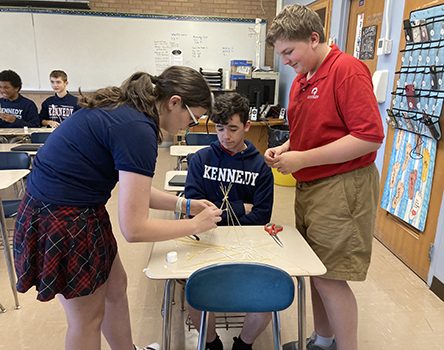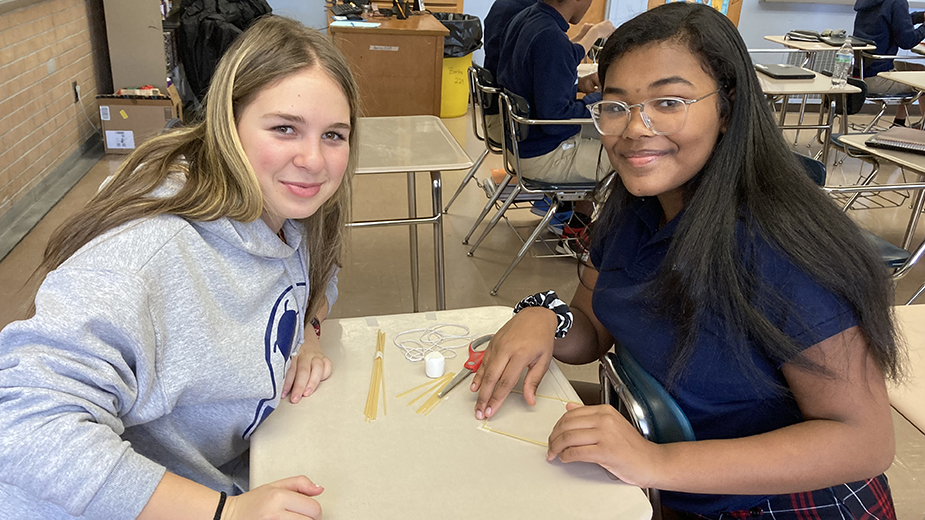YOUNGSTOWN, Ohio – An academic curriculum that was created to expose middle school students to manufacturing concepts is a hit with John F. Kennedy Catholic School eighth-graders.
“I love this class,” says Sophia Bonacker, one of those students at the Warren school.
“This class is the best,” adds her classmate, Antonio Pacheco. “We can let our minds run free.”
Sophia doesn’t think of herself as creative. But she says her teacher, Brandie Bartoe, is teaching her how to think creatively.
“She’s a really good teacher,” Antonio agrees.
The curriculum was designed by the Mahoning Valley Manufacturers Coalition.
At a class in early November, Bartoe’s science, technology, engineering and mathematics (STEM) students were using everyday supplies to build a structure.
Bartoe distributed to each team of students a bundle of dry spaghetti, a marshmallow, two strips of masking tape and a piece of string.
The assignment, dubbed the marshmallow challenge, was to build the tallest, sturdiest structure they could and top it with a marshmallow. The students could use as many or as few of the materials as they needed. The sturdiness would be tested with a fan set at increasing speeds until a winner is crowned.
The students divide into groups of two or three and huddle around their desks to get to work, first discussing and then building.
Other portions of the MVMC curriculum undertaken by the JFK eighth-graders involved building a catapult and working with circuits.
The curriculum was developed to Ohio academic standards by MVMC and Terri Fleming, an engineering and robotics teacher at Trumbull Career and Technical Center. The Manufacturers Coalition makes it available to middle schools throughout Mahoning, Trumbull and Columbiana counties.
Bartoe says the curriculum is hands-on and appeals to students who may not enjoy traditional classroom work.
RAISING AWARENESS
Allison Engstrom, project manager at MVMC, says the curriculum exposes students to manufacturing concepts earlier in their education.
“The goal in creating the curriculum was to raise awareness and interest in manufacturing,” she says.
Bartoe says students may not be aware that manufacturing is a good career option.
“The more you can expose them to different opportunities and things, the better and more well-rounded and prepared they’ll be,” she says.
The curriculum, new this year, covers seven lessons.
They’re designed to enable students to understand the importance of teamwork in manufacturing, learn skills important in manufacturing, explore manufacturing careers, learn how technology is used in manufacturing and learn about new industries like additive manufacturing.
Teachers may pick the lessons they want to use.
“I look for things that work well, that the kids are engaged in,” Bartoe says. “The class is hands-on so I’m looking for hands-on activities. MVMC provides the materials for us to use for free.”
Sophia and Antonio started with a teepee design for their structure, but at first it didn’t work.
“We kind of grew on our original idea. So once we started building more, we learned if you put more pieces [of spaghetti] on, it would be stronger, so we just kept adding pieces,” Sophia says.
They assembled the pasta in a teepee shape.
Rather than taping the noodles all together, they used the marshmallow.
“We discovered the marshmallow is very reliable,” Antonio says. “It’s better than the tape because it’s just going to keep them all together.”
The team of Reese Killingworth and Zoie Luzadder used a different idea for the project than the others in the class.
“To make it sturdy, we’re going to try to make it square,” Reese explains. “And then we’re going to make a triangle on top.”
They reason that a larger base would lend strength.
Although neither knows what profession she may pursue after high school, they both like STEM class and the hands-on projects.
“It comes easy to me,” Reese says.
“I like to build things,” adds Zoie.
Kaiden Bloom and Nick Branca give similar reviews.
“It’s a pretty cool class,” Kaiden says.
Nick likes it because it’s “using your mind to overcome challenges. This is pretty hard. You have to build a sturdy structure with something that maybe isn’t the sturdiest resource,” he says, meaning the pasta. “It bends a lot. It’s kind of cool how you have to think outside the box.”
CRITICAL THINKING
Engstrom says the marshmallow project encourages teamwork, design and critical thinking.

“They were given a challenge,” she says. “Just like in manufacturing, your customer asks you to create the product. So, this is what they’ve been asked to create.”
Each team of students designed different structures to fulfill the requirements. As long as they meet the criteria, they achieve the challenge. It gives the students the opportunity to problem-solve more so than in a traditional classroom, Bartoe says.
Sometimes it involves trial and error.
“We started to come up with one plan together and it didn’t work,” says Reid Robinson who teamed with Madison Miner and Blake Mekker on the project.
Then Reid suggested another option and they went to work on it. “I like that we can actually use our creativity,” he says.
Madison enjoys the teamwork required too.
“We can combine our ideas together and come up with a system,” she says. “It’s very cool.”
Reid says each team member uses their strengths and they work together to develop the projects. Blake says it’s a relaxing class and a good way to end the school day.
Bartoe, the teacher, likes it too.
“Yes,” shouts one of the students who just came up with a new idea.
“See, that’s why,” Bartoe says. “The kids are engaged and it’s fun. And it’s different every day.”
Pictured at top: John F. Kennedy eighth-graders Zoie Luzadder and Reese Killingworth work on their STEM project. The assignment, dubbed the marshmallow challenge, was to build the tallest, sturdiest structure they could and top it with a marshmallow.
